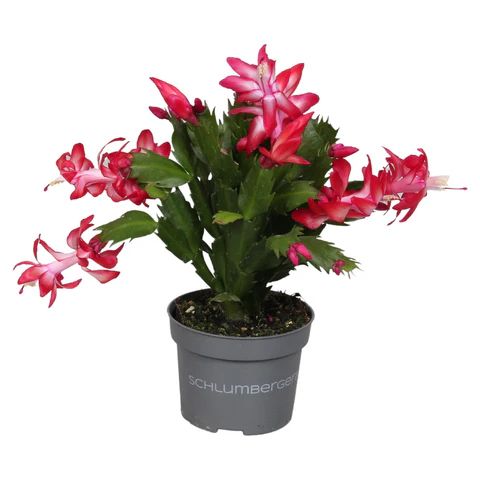Thanksgiving Cactus (Schlumbergera truncata)
Last
updated: August 3,
2025
Care Sheet List
The
Thanksgiving Cactus, a popular houseplant, is cherished for its
vibrant,
tubular flowers that typically bloom in late fall and early winter.
Unlike
desert cacti, these are epiphytic jungle cacti, meaning they grow on
trees in
their natural habitat, not in soil.
Lighting
Thanksgiving
Cacti thrive in bright, indirect light. Direct
sunlight, especially
harsh afternoon sun, can scorch their delicate stems and cause them to
turn
reddish. An east-facing window is ideal, providing gentle morning sun.
A
north-facing window might be too dim, while a west or south-facing
window may
require sheer curtains for protection.
Watering
Routine
Water your
Thanksgiving Cactus when the top 1-2 inches of soil feel dry
to the touch.
They prefer consistent moisture during their active growing and
blooming
periods, but absolutely do not like to sit in soggy soil,
which can lead
to root rot. Water thoroughly until water drains from the bottom of the
pot,
and then empty any excess water from the saucer immediately. Reduce
watering
significantly after blooming (around late winter/early spring) and
during their
semi-dormant period in summer.
Fertilizer
Requirements
Fertilize
your Thanksgiving Cactus during its active growing season, primarily
from spring
through early fall.
- Type: Use a balanced
liquid houseplant fertilizer or one slightly higher in phosphorus to
encourage blooming (e.g., a "bloom booster" formula).
- Commercial Recommendation: Miracle-Gro
Indoor Plant Food (Liquid) or Schultz Liquid Plant
Food are good options. Dilute these commercial concentrates to achieve approximately 25-50 ppm N
in your final solution, applied every 2-4 weeks. This is often
equivalent to using them at "half strength" or "quarter strength" of
the package's recommended dose.
- DIY Fertilizer Suggestion: For optimal blooming, use your homemade 1-2-1 liquid fertilizer concentrate (High Phosphorus) or a balanced 1-1-1 liquid fertilizer concentrate.
- For 1-2-1 concentrate (10,000 ppm N): Apply at a "Light Feeding" rate, using 5 ml per 1 liter of water (resulting in ~50 ppm N, 100 ppm P₂O₅, 50 ppm K₂O). See recipe details.
- For 1-1-1 concentrate (10,000 ppm N): Apply at a "Light Feeding" rate, using 5 ml per 1 liter of water (resulting in ~50 ppm N, 50 ppm P₂O₅, 50 ppm K₂O). See recipe details.
- Important: Stop
fertilizing around late September to encourage bud formation for their
winter bloom. Resume after blooming.
Misting
Requirements
Thanksgiving
Cacti are native to humid, tropical environments and appreciate moderate
to
high humidity.
- Regular misting (daily or every
few days) with room-temperature water is beneficial, especially in dry
indoor environments or during winter when heating is on.
- Placing the pot
on a pebble tray filled with water (ensuring the
pot does not sit in the water) can also effectively increase ambient
humidity. Grouping it with other plants also helps create a
microclimate.
Pot Size
and Soil Type
- Pot Size: Thanksgiving
Cacti prefer to be somewhat root-bound, which can
encourage more abundant blooms. They don't need frequent repotting.
When repotting (best done after blooming, in late winter/early spring),
choose a pot that is only 1-2 inches larger in diameter
than the current one. Ensure the pot has excellent drainage
holes.
- Soil Type: As epiphytes,
they need a very well-draining, airy, and slightly acidic
potting mix. Standard potting soil is too heavy and retains
too much moisture.
- An ideal mix
often includes elements like orchid bark, perlite, and peat
moss or coco coir.
- You can create a
suitable mix by combining:
- 1 part quality
potting mix (or peat moss/coco coir)
- 1 part perlite
(medium or coarse)
- 1/2 part small
orchid bark or coarse sand
- NOTE: We used
this mix
- 1 part
Miracle-Gro Palm, Cactus & Citrus Potting Mix
- 1 part Perlite
(Vigoro fine/medium mix)
- 1/2 part Peat
Moss
Promoting
Blooms
To encourage
abundant flowering, a Thanksgiving Cactus needs a period of cool
temperatures and short days/long nights (around 12-14 hours
of
uninterrupted darkness).
- Starting in early
fall (late September/early October), expose the plant to
cooler temperatures (around 50-55°F or 10-13°C) and
ensure it receives 12-14 hours of complete darkness each night for 4-6
weeks. Even a brief flash of light at night can disrupt bud formation.
- After buds have
set, you can move the plant back to its normal, slightly warmer (but
still cool) location, and resume a regular watering schedule.


